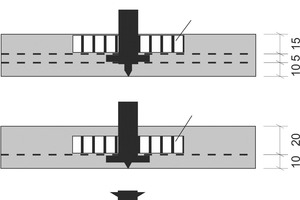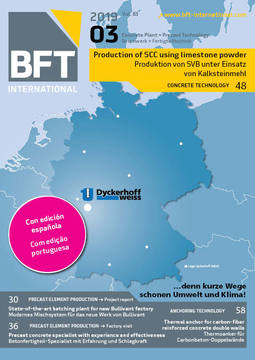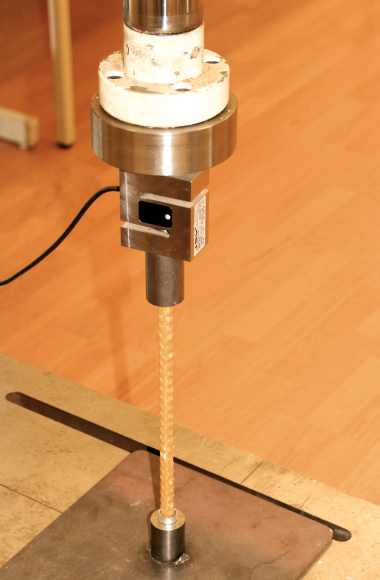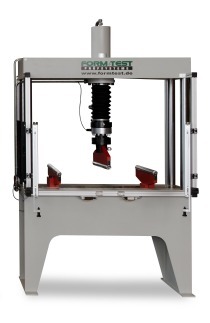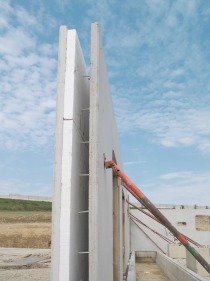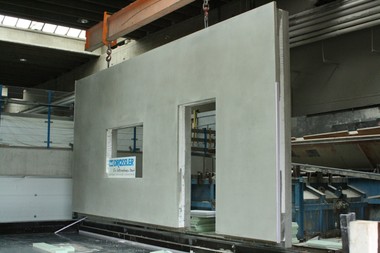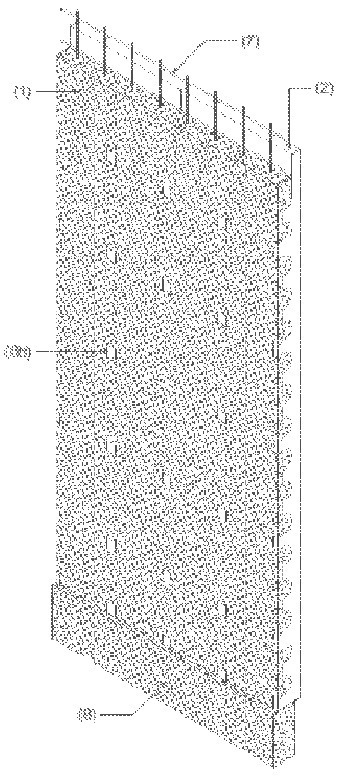Thermal anchor for carbon-fiber reinforced concrete double walls
Thermal double walls can be considerably thinner and lighter if they are manufactured using carbon-fiber reinforced concrete. That means more space in the finished building and advantages for transportation to the building site. However, conventional means of connection are unsuitable for the connection of the wall shells. This paper presents a new type of thermal anchor with which the connection of the shells can be successfully accomplished.
Double walls or thermal double walls made of reinforced concrete have long been used in the precast industry. On account of their high degree of prefabrication and their function as permanent formwork on the building site, where the individual elements are connected by means of an in-situ concrete filling, the semi-precast parts have proven to be a cost-effective solution. A thermal double wall normally consists of two reinforced concrete wall shells with a thickness of 6 to 7 cm. In between them there is a layer of thermal insulation and a void to be filled with cast-in-situ concrete [1]. The thickness of the wall shells is mainly due to the need to protect the reinforcing steel against corrosion and not for reasons of statics. Negative side effects here are the high transport weight of an individual wall element and the decrease in the usable space in the completed building.
This is where the high-performance material carbon-fiber reinforced concrete comes into play. With its textile, non-corroding carbon-fiber reinforcement it is particularly suitable for lean, laminar structural elements (e.g. [2][3]). The unnecessarily thick reinforced concrete shells of a thermal double wall could each be reduced to a thickness of just 3 cm if made of carbon-fiber reinforced concrete (cf. [4]). Without changing the dimensions of the core, it is thus possible to save 7 cm of wall thickness (Fig. 1).
In the conventional thermal wall, steel lattice girders or, to avoid heat bridges, thermal anchors made of glass-fiber reinforced plastic (GRP) are used to connect the wall shells. Irrespective of the type of connector, however, the same problem occurs with all of them if the thickness of the wall shells is reduced: The embedment depth in the concrete is too small to be able to transmit the forces that arise. Therefore, a new solution had to be found that meets the following requirements:
1. It must be possible to integrate the connector in the fully automated production process in a precast plant.
2. The geometry of the connector must be adapted to suit the narrow mesh size of the reinforcing textile.
3. The connector must be capable of absorbing the forces arising during the manufacture, transportation and assembly of the thermal double wall.
4. The connector must not form a heat bridge in the thermal wall.
All of these criteria are fulfilled by a newly developed thermal anchor for carbon-fiber reinforced double walls (Fig. 2). This is the result of research in the Twenty20 project C³-V1.1 „Production“ [5] and cooperation between Betonwerk Oschatz GmbH, EnergieAutark GmbH, FISSEK GmbH, the Institute of Concrete Construction at the HTWK Leipzig and the Institute of Structural Concrete at Techni-sche Universität Dresden (Technical University of Dresden).
2. Functional principle of the thermal anchor
The thermal anchor has a rod shape with two different ends. The first end with a square plate was designed both for single and double-layer reinforcement of the wall shell. Prior to the concreting of the first wall shell, which will subsequently be the outer shell of the thermal wall, this square plate is fed through the mesh of the reinforcing textile and then turned by 45° so that the textile lies on the plate. The size of the plate was adapted to suit the 38 mm mesh size of a currently frequently used textile – solidian GRID Q95/95-CCE-38 [6]. If the wall shell is to be provided with double-layer reinforcement, the plate is fed only through the upper textile layer, while the lower layer rests on conventional spacers. In order to fix the fabric to the anchor, avoid tilting of the anchor and retain the vertical position of the anchor during concreting, it is fixed by a wheel-shaped clip (Fig. 3). Thus, there is no need for any aid such as a tripod supporting from underneath and visible on the concrete surface. Apart from the spacing function for the textile fabric, the square anchor head also ensures the bond with the concrete.
Following the concreting of the first wall shell it can additionally be provided with thermal insulation. Once the concrete has hardened, the wall shell is turned by 180° by means of a vacuum turning frame and lowered, plunging the other end of the thermal anchor into the freshly concreted and reinforced second shell (Fig. 4). On the one hand this second end has a serrated form to ensure a good bond with the concrete and on the other the tip is formed in such a way that the thermal anchor, if it should encounter a fiber strand, slips off the fabric instead of depressing it and is guided through the textile mesh (Fig. 5).
The geometry of the thermal anchor is the result of numerous manufacturing experiments at Betonwerk Oschatz. These experiments conclusively confirmed the functional principle and integration of the thermal anchor in the manufacturing process and enabled the production of a prototype of a double wall measuring 1 x 1 m² (Fig. 6).
3. Laboratory investigations
3.1. General information
Whereas the first two requirements for the thermal anchor had now been met, the question of their mechanical suitability remained unanswered. In order to test the anchor in a bond with the concrete, load capacity tests were carried out on small test specimens in the Otto Mohr Laboratory at the Technical University of Dresden (see also [4]). The major influences expected in practical use were mapped in the tests. The following were tested: resistance to axial force as a consequence of the self weight of the first concreted shell during immersion in the second; transverse shear pull as a consequence of the self weight during transportation and axial pull as a consequence of the concreting pressure when filling on the building site and if applicable during demolding. The first load can already occur at a component age of one day; therefore, selected scenarios were tested both on one day-old and 28 day-old test specimens. Figure 7 shows the principle of the conceivable effects.
3.2. Test specimens
The test specimens consisted of reinforced concrete cubes into which the thermal anchors were centrally cast. The thermal anchors were separated in the middle prior to concreting so that both ends could be tested. The size of the basic concrete body was limited by the free space in the test machine and was defined as 200 mm (l) x 110 mm (w) x 30 mm (h). The thickness corresponded to that of the desired wall shell thickness. The position of the reinforcement was dictated by the boundary conditions in the precast plant. In the case of the single-layer reinforced test specimens this was located at a height of 10 mm; in the case of the two-layer reinforced test specimens the position of the second textile layer was dictated by the plate-shaped anchor head (Fig. 8). Since the plate-shaped end is to be secured by a clip later on, this clip was also cast in the concrete in order to check whether an interfering effect is to be expected.
The test specimens were manufactured using a casting method with a high strength concrete mix specially developed for textile concrete applications, with 5 mm broken grain as the largest grain and sand, fine sand, water and a binder compound consisting of Portland cement clinker, granulated blast furnace slag and limestone flour [7]. The textile reinforcement used was the same carbon fabric that was also the basis for the determination of the geometry of the plate-shaped anchor head. Following their manufacture, the test specimens were covered with film and demolded after one day. Test specimens that were not tested directly at an age of one day were stored at 20 °C and 65 % relative humidity in the climate chamber until being tested at an age of 28 days.
3.3. Tests
All tests were carried out in a servo-hydraulic testing machine. Five different variants were thereby tested. In addition to the four variants shown in Figure 8, a conventional thermal anchor for reinforced concrete double walls was examined in the same test setup as variant 1 as a reference (see also [4]).
The results can be regarded as positive throughout. In the axial force tests all test specimens failed through a conical concrete pry out failure. However, the serrated rod end (variant 1) was able to transmit loads twice as high as the plate-shaped end (variants 2 and 3). As a consequence, the second reinforcement layer at the plate-shaped end (variant 3) had only a low load increase in comparison with variant 2.
In the axial pull tests, loads twice as high as in the axial force tests were achieved with all variants. In this case also, all test specimens failed through conical concrete pry out failure. The new thermal anchor even accepted loads twice as high as the reference rod for reinforced concrete double walls. An additional reinforcement layer did not result in a further load increase in the axial pull tests. What is pleasing, however, is that the clip for the vertical fixing of the thermal anchor in variants 2 and 3, which was also cast in the concrete, did not cause any reduction in the load capacities.
In the transverse shear pull tests, virtually identical maximum loads were achieved with all the rod ends examined. The reason for this was that neither the concrete nor the textile failed; instead, the thermal anchors broke off as a result of bending.
In order to better classify the results achieved, they were compared with the expected effects. The axial pull load case proved to be decisive [8]. If the effects due to the self weight [9] at an age of one day gk,1d are compared with the lowest value achieved in the test Rk,1d as the resistance, then at least one thermal anchor is required per square meter of wall:
However, if after 28 days the fresh concrete pressure gk,28d ≥ 25 kN/m² according to DIN 18218 [10] is applied as the effect and the lowest value from the tests after 28 days Rk,28d is applied as the resistance, then at least seven thermal anchors are necessary per square meter:
If one takes the test results of the reference rod for reinforced concrete double walls, which exhibited only half of the load capacity of the new thermal anchor in the tests, and inserts them in both calculations, then the result would be twice the number of rods per square meter. The goal – that of improving the bond with low embedment depths – was thus clearly reached.
4. Further information
The foregoing sections dealt intensively with the functional principle, geometry and mechanical mode of operation of the newly developed thermal anchor for carbon-fiber reinforced concrete double walls. However, the anchor also has to meet requirements in terms of building physics. To this end, laboratory tests were carried out at the Institute of Concrete Construction at the HTWK Leipzig in order to determine the heat bridge coefficients of the thermal anchor in a thermal double wall [4][8]. These tests showed that the thermal anchor has only a very minor effect on the double wall construction and is therefore very well suited in terms of building physics. This is also due to the choice of material – glass-fiber reinforced plastic.
All of the laboratory and manufacturing tests presented were carried out on prototypes of the thermal anchor, which were manufactured by Fissek GmbH in Mylau using a CNC turning method. Due to the great loss of material, however, this method is very uneconomical for the production of large numbers. Prospectively, therefore, it would be advantageous to use an injection molding method.
On September 12, 2018, application was made for a patent for the thermal anchor and its functional principle for installation in a double wall [11]. Nevertheless, a further extensive program of tests on small and large test specimens and structural elements is unavoidable if a permit is to be obtained that will allow practical use of the thermal anchor in construction.

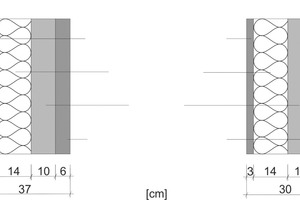
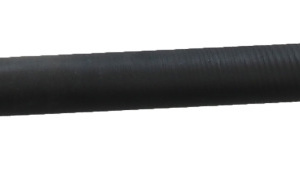
![3 Fixing of the thermal anchor with a clip [4]](https://www.bft-international.com/imgs/1/4/0/9/2/5/0/tok_14acb5147408181efcb12dc9f94288f2/w300_h200_x600_y289_Bild_3-c82868933028e90c.jpeg)
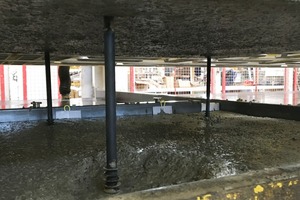
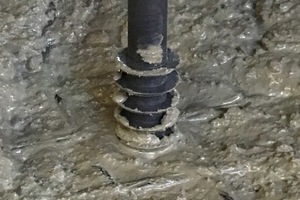
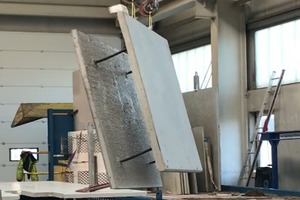
![7 Expected effects: a) axial force, b) transverse shear pull, c) axial pull [4]](https://www.bft-international.com/imgs/1/4/0/9/2/5/0/tok_fb62ab019f0912ee8eac168af47a1738/w300_h200_x600_y187_Bild_7-801f972770bc815b.jpeg)
